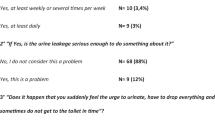Abstract
The goal of this study was to analyze the risk factors associated with vaginal erosion after synthetic sling procedure for stress urinary incontinence. Follow-up evaluations were at 1 week, 1 to 3 months, 6 months, and annually after the operation. The evaluations included detailed history taking, vaginal examinations, and perineal ultrasonographic urethrocystography. The vaginal erosion rate (6/239) after the synthetic sling procedure was 2.5%. We assessed the relationship between clinical features and vaginal erosion. Of these, only diabetes mellitus (DM) was a significant risk factor for vaginal erosion. Women with DM were 8.3 times more at risk than women without DM for developing vaginal erosion after synthetic sling procedure (p < 0.05). The vaginal erosion-free rate during the 24-month follow-up decreased significantly in women with DM. The rate of vaginal erosion associated with type III multifilamentous polypropylene sling (intravaginal slingplasty) is 10.7% more than that with type I monofilament polypropylene sling (such as tension-free vaginal tape and inside out transobturator vaginal tape) (p = 0.054). Women with DM should be informed that vaginal erosion is a possible complication after synthetic sling procedure.

Similar content being viewed by others
Abbreviations
- TVT:
-
tension-free vaginal tape
- TVT-O:
-
inside out transobturator vaginal tape
- IVS:
-
intravaginal slingplasty
- SUI:
-
stress urinary incontinence
- DM:
-
diabetes mellitus
References
Ulmsten U, Henriksson L, Johnson P, Varhos G (1996) An ambulatory surgical procedure under local anesthesia for treatment of female urinary incontinence. Int Urogynecol J Pelvic Floor Dysfunct 7:81–86
Baessler K, Maher CF (2006) Mesh augmentation during pelvic-floor reconstructive surgery: risks and benefits. Curr Opin Obstet Gynecol 18:560–566
Flock F, Reich A, Muche R, Kreienberg R, Reister F (2004) Hemorrhagic complications associated with tension-free vaginal tape procedure. Obstet Gynecol 104:989–994
de Leval J (2003) Novel surgical technique for the treatment of female stress urinary incontinence: transobturator vaginal tape inside-out. Eur Urol 44:724–730
Karram MM, Segal JL, Vassallo BJ, Kleeman SD (2003) Complications and untoward effects of the tension-free vaginal tape procedure. Obstet Gynecol 101:929–932
Deval B, Haab F (2006) Management of the complications of the synthetic slings. Curr Opin Urol 16:240–243
Petros P, Ulmsten U (1993) The development of the intravaginal slingplasty procedure: IVS II–VI. Scand J Urol Nephrol Suppl 153:61–84
Meschia M, Pifarotti P, Bernasconi F, Guercio E, Maffiolini M, Magatti F et al (2001) Tension-free vaginal tape analysis of outcomes and complications in 404 stress incontinent women. Int Urogynecol J Pelvic Floor Dysfunct 12 (Suppl):S24–S27
Kuuva N, Nilsson CG (2002) A nationwide analysis of complications associated with the tension-free vaginal tape (TVT) procedure. Acta Obstet Gynecol Scand 81:72–77
Levin I, Groutz A, Gold R, Pauzner D, Lessing JB, Gordon D (2004) Surgical complications and medium-term outcome results of tension-free vaginal tape: a prospective study of 313 consecutive patients. Neurourol Urodyn 23:7–9
Bafghi A, Benizri EI, Trastour C, Benizri EJ, Michiels JF, Bongain A (2005) Multifilament polypropylene mesh for urinary incontinence: 10 cases of infections requiring removal of the sling. BJOG 112:376–378
Baessler K, Hewson AD, Tunn R, Schuessler B, Maher CF (2005) Severe mesh complications following intravaginal slingplasty. Obstet Gynecol 106:713–716
Glavind K, Sander P (2004) Erosion, defective healing and extrusion after tension-free urethropexy for the treatment of stress urinary incontinence. Int Urogynecol J Pelvic Floor Dysfunct 15:179–182
Cervigni M, Natale F (2001) The use of synthetics in the treatment of pelvic organ prolapse. Curr Opin Urol 11:429–435
Takoudes TC, Weitzen S, Slocum J, Malee M (2004) Risk of cesarean wound complications in diabetic gestations. Am J Obstet Gynecol 191:958–963
Onodera H, Ikeuchi D, Nagayama S, Imamura M (2004) Weakness of anastomotic site in diabetic rats is caused by changes in the integrity of newly formed collagen. Dig Surg 21:146–151
Wang AC, Lee LY, Lin CT, Chen JR (2004) A histologic and immunohistochemical analysis of defective vaginal healing after continence taping procedure: a prospective case-controlled pilot study. Am J Obstet Gynecol 191:1868–1874
Bent AE, Ostergard DR, Zwick-Zaffuto M (1993) Tissue reaction to expanded polytetrafluoroethylene suburethral sling for urinary incontinence: clinical and histologic study. Am J Obstet Gynecol 169:1198–1204
Achtari C, Hiscock R, O’Reilly BA, Schierlitz L, Dwyer PL (2005) Risk factors for mesh erosion after transvaginal surgery using polypropylene (Atrium) or composite polypropylene/polyglactin 910 (Vypro II) mesh. Int Urogynecol J Pelvic Floor Dysfunct 16:389–394
Acknowledgements
The authors would like to thank the China Medical University Hospital for financially supporting this research under Contract DMR-95-068 and DMR-96-099.
Author information
Authors and Affiliations
Corresponding author
Rights and permissions
About this article
Cite this article
Chen, HY., Ho, M., Hung, YC. et al. Analysis of risk factors associated with vaginal erosion after synthetic sling procedures for stress urinary incontinence. Int Urogynecol J 19, 117–121 (2008). https://doi.org/10.1007/s00192-007-0400-2
Received:
Accepted:
Published:
Issue Date:
DOI: https://doi.org/10.1007/s00192-007-0400-2




